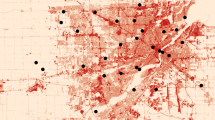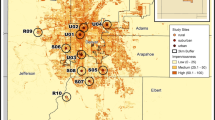Abstract
Urban environments have become an unexpected and promising avenue for pollinator conservation. One group of pollinators, bumble bees, might be especially well suited to utilize the heterogeneous landscape of urban ecosystems. Weedy margins (pervious land adjacent to impervious surfaces such as roads and paved lots) offer plentiful flowers for bees, but are often overlooked in urban pollinator studies. If weedy margins buffer urban bees from loss and fragmentation of foraging habitat in cities, then urban development may not have as strong of a negative effect on bumble bees as previously thought. In this study we test the hypothesis that bumble bee abundance and species richness in these weedy margins will not be affected by the degree of urbanization. We surveyed bees and flowers within weedy plots of land in six industrial cities of the Midwestern USA. Bumble bee abundance and richness were not influenced by the proportion of intensely developed land in the surrounding landscape, but abundance increased with local floral abundance. Bumble bees were also significantly more abundant than other bee groups (honeybees and ‘other’ wild bees). We found that weedy margins and weedy plant species provide important resources to urban pollinators, and to bumble bees in particular. If small patches of habitat can sustain bees in the city, future efforts of urban pollinator conservation could focus on the installation of high-quality micro-meadows, increasing the availability of quality habitat for pollinators.




Similar content being viewed by others
References
Ahrné K, Bengtsson J, Elmqvist T (2009) Bumble bees (Bombus spp) along a gradient of increasing urbanization. PLoS One 4(5):e5574
Baldock KCR, Goddard MA, Hicks DM, Kunin WE, Mitschunas N, Morse H, Osgathorpe LM, Potts SG, Robertson KM, Scott AV, Staniczenko PPA, Stone GN, Vaughan IP, Memmott J (2019) A systems approach reveals urban pollinator hotspots and conservation opportunities. Nat Ecol Evol 3(3):363–373
Banaszak-Cibicka W, Twerd L, Fliszkiewicz M, Guejdasz K, Langowska A (2018) City parks vs. natural areas – is it possible to preserve a natural level of bee richness and abundance in a city park? Urban Ecosyst 21:599
Bennett AB, Lovell S (2019) Landscape and local site variables differentially influence pollinators and pollination services in urban agricultural sites. PLoS One 14(2):e0212034
Cameron SA, Lozier JD, Strange JP, Koch JB, Cordes N, Solter LF, Griswold TL (2011) Patterns of widespread decline in north American bumble bees. PNAS 108:662–667
Colla SR, Packer L (2008) Evidence for decline in eastern North American bumblebees (Hymenoptera: Apidae), with special focus on Bombus affinis Cresson. Biodivers Conserv 17(6):1379–1391
ESRI (2016) ArcGIS desktop: release 10.3.0.4322 Environmental Systems Research Institute, Redlands, California
Fortel L, Henry M, Guilbauld L, Guirai AL, Kuhlmann M et al (2014) Decreasing abundance, increasing diversity, and changing structure of the wild bee community (Hymenoptera: Anthophila) along an urbanization gradient. PLoS One 9(8):104679
Geslin B, Le Féon V, Folschweiller M, Flacher F, Carmignac D, Motard E, Perret S, Dajoz I (2016) The proportion of impervious surfaces at the landscape scale structure wild bee assemblages in a densely populated region. Ecol Evol 6(18):6599–6615
Glaum P, Simao M-C, Vaidya C, Fitch G, Iulinao B (2017) Big city Bombus: using natural history and land-use history to find significant environmental drivers in bumble-bee declines in urban development. R Soc Open Sci 4:170156
Goulson D (2012a) Chapter 1: introduction. In: Bumblebees behavior, ecology, and conservation, 2nd edn. Oxford University Press, Oxford, pp 1–12
Goulson D (2012b) Chapter 3: social organization and conflict. In: Bumblebees behavior, ecology, and conservation, 2nd edn. Oxford University Press, Oxford, pp 21–43
Goulson D (2012c) Chapter 6: foraging economics. In: Bumblebees behavior, ecology, and conservation, 2nd edn. Oxford University Press, Oxford, pp 81–99
Goulson D (2012d) Chapter 8: choice of flower species. In: Bumblebees behavior, ecology, and conservation, 2nd edn. Oxford University Press, Oxford, pp 113–129
Goulson D, Lye GC, Darvill B (2008) Decline and conservation of bumble bees. Annu Rev Entomol 53:191–208
Goulson D, Nicholls E, Botias C, Rotheray EL (2015) Bee declines driven by combined stress from parasites, pesticides, and lack of flowers. Science 347(6229):1255957–1255957
Grixti JC, Wong LT, Cameron SA, Favret C (2009) Decline of bumble bees (Bombus) in the north American Midwest. Biol Conserv 142(1):75–84
Hall DM, Camilo GR, Tonietto RK, Ollerton J, Ahrné K, Arduser M, Ascher JS, Baldock KCR, Fowler R, Frankie G, Goulson D, Gunnarsson B, Hanley ME, Jackson JI, Langellotto G, Lowenstein D, Minor ES, Philpott SM, Potts SG, Sirohi MH, Spevak EM, Stone GN, Threlfall CG (2017) The city as a refuge for insect pollinators. Conserv Biol 31(1):24–29
Homer CG, Dewitz JA, Yang L, Jin S, Danielson P, Xian G, Coulston J, Herold ND, Wickham JD, Megown K (2015) Completion of the 2011 National Land Cover Database for the conterminous United States-representing a decade of land cover change information. Photogrammetric Engineering and Remote Sens 81:345–354
Kerr JT, Pindar A, Galpern P, Packer L, Potts SG, Roberts SM, Rasmont P, Schweiger O, Colla SR, Richardson LL, Wagner DL, Gall LF, Sikes DS, Pantoja (2015) Climate change impacts on bumblebees converge across continents. Science 349(6244):177–180
Kluser S, Peduzzi P (2007) Global pollinator decline: a literature review. UNEP/GRID Europe https://www.researchgate.net/publication/239903454_Global_Pollinator_Decline_A_Literature_Review. Accessed 27 May 2017
Lanterman J, Reeher P, Mitchell RJ, Goodell K (2019) Habitat preference and phenology of nest seeking and foraging spring bumble bee queens in northeastern North America (Hymenoptera: Apidae: Bombus). Am Midl Nat 182(2):131–159
Larson JL, Kesheimer AK, Potter DA (2014) Pollinator assemblages on dandelions and white clover in urban and suburban lawns. J Insect Conserv 18(5):863–873
Liu Z, He C, Zhou Y, Wu J (2014) How much of the world’s land has been urbanized, really? A hierarchical framework for avoiding confusion. Landsc Ecol 29(5):763–771
Lowenstein DM, Matteson KC, Minor ES (2019) Evaluating the dependence of urban pollinators on ornamental, non-native, and ‘weedy’ floral resources. Urban Ecosyst 22:293–302
MacIvor JS, Cabral JM, Packer L (2014) Pollen specialization by solitary bees in an urban landscape. Urban Ecosyst 17:139–147
McFrederick QS, LeBuhn G (2006) Are urban parks refuges for bumble bees Bombus spp. (Hymenoptera: Apidae)? Biol Conserv 129(3):372–382
Michener CD (2007) Chapter 119: tribe Bombini. In: The bees of the world, 2nd edn. The John Hopkins Press, Baltimore, pp 785–802
Ollerton J., Winfree R., Tarrant S (2011) How many flowering plants are pollinated by animals? Oikos 120(3):321 – 326
Pallagst KM, Wiechmann T, Martinez-Fernandez C (2011) Shrinking cities; international perspectives and policy implications. Routledge, New York
Potts SC, Beismeijer JC, Kremen C, Neumann P, Schweiger O, Kunin WE (2010) Global pollinator declines: trends, impacts and drivers. Trends in Ecol Evol 25(6):345–353
SAS Institute Inc (2012) SAS/ACCESS® 9.4 Interface to ADABAS: Reference. SAS Institute Inc, Cary
Saville NM (1993) Bumblebee ecology in woodlands and arable farmland. University of Cambridge, Dissertation
Shetty S (2009) Shrinking cities in the Industrial Belt: a focus on small and mid-size cities in northwestern Ohio. University of Toledo Urban Affairs Center. https://www.utoledo.edu/centers/urban-affairs/publications/WORC-UAC-Shrinking-Cities.pdf. Accessed 11 May 2017
Sivakoff FS, Prajzner SP, Gardiner MM (2018) Unique bee communities within vacant lots and urban farms results from variation in surrounding urban intensity. Sustainability 10(6):1926
Szymanski, J, Smith, T, Horton, A, Parking, M, Raga, L, Masson, G, Olson, E, Gifford, K, Hill, L (2016) Rusty patched bumble bee (Bombus affinis) species status assessment. Final report version 1. USFWS. https://www.fws.gov/midwest/Endangered/insects/rpbb/pdf/SSAReportRPBBwAdd.pdf
Williams P, Thorp R, Richardson L, Colla S (2014) An identification guide to bumble bees of North America. Princeton University Press, Princeton
Wood TJ, Gibbs J, Graham KK, Isaacs R (2019) Narrow pollen diets are associated with declining Midwestern bumble bee species. Ecology 100(6):e02697
Acknowledgements
We are grateful to Elizabeth DiCesare and Sarah Schmucker for their help with data collection. We thank Karen Goodell for her assistance in obtaining funding and guidance. We also thank the Ohio Department of Transportation and the University of Akron for funding this research.
Funding
This study was partially funded by the Ohio Department of Transportation, grant number 30571, and by the University of Akron Biology Department.
Author information
Authors and Affiliations
Corresponding author
Ethics declarations
Conflict of interest
The authors declare that they have no conflict of interest.
Rights and permissions
About this article
Cite this article
Reeher, P., Lanterman Novotny, J. & Mitchell, R.J. Urban bumble bees are unaffected by the proportion of intensely developed land within urban environments of the industrial Midwestern USA. Urban Ecosyst 23, 703–711 (2020). https://doi.org/10.1007/s11252-020-00965-9
Published:
Issue Date:
DOI: https://doi.org/10.1007/s11252-020-00965-9




